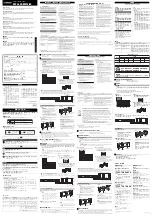
26
1/4” Headphone Jack Pads (J302)
F
Tip
G
Tip (norm. closed contact)
H
Ring
J
Ring (norm. closed contact)
K
Common (ground)
Key/Paddle Pads J301 (no drawing shown)
L
Tip (dot)
M
Ring (dash)
N
Common (ground)
(21) Microphone Jack Wiring: The microphone wiring table silkscreened onto the rear of
the circuit board corresponds to the sixteen pads that are centered between the two
microphone access holes. Although some microphones have numerous features (UP,
DOWN, etc.), at a minimum all have at least three conductors: an audio output wire
(Mic+), a PTT wire; and a ground (shield) wire. If a microphone jack has a separate
“Mic Gnd” or “Mic-” wire, then connect it to the Mic- pad and not to GND.
Note that there are four rows of pads labeled FN1-FN4 on the silkscreened table.
These pads, along with the Mic- pads, differ from the Mic+ and PTT pads because both
pads in each row, FN1 for example, are jumpered together on the circuit board. You can
assign the other microphone wires (e.g., UP, DOWN, +V, etc.) to FN1-4, in any order
you like, but be sure to assign the corresponding wires on each microphone to the same
pads. In other words, if you assign FAST to FN1 for Microphone 1, then you should also
assign FAST to FN1 for Microphone 2. The following table shows recommended pad
assignments for common 8-pin microphone pinouts used in contemporary transceivers.
IMPORTANT: if you do not use any of the FN1-4 rows, then jumper an unused
pad on that row to the GND pad. However, if a pad, such as FN4, is used only on one
microphone but not on the other, then do NOT ground the unused FN4 pad.
Now trim the
wires from each microphone jack to size, tin the ends, and solder each wire to its pad,
according to the table. Be especially careful to avoid short circuits from loose wire
strands or solder bridges on the Mic+ pads (Pin nos. 1,9) and PTT pads (Pin nos. 2,10).
















































